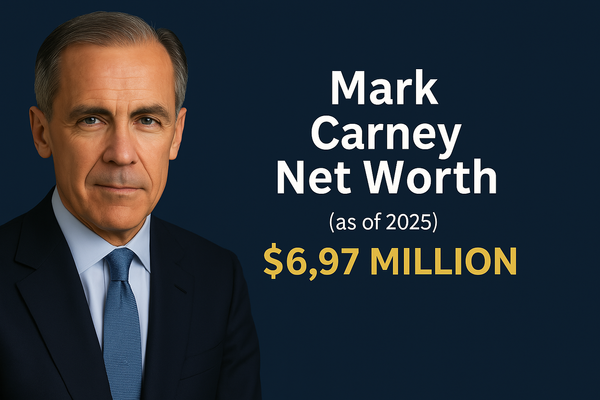Pierre Poilievre Promises Major Tax Cuts in Election Kickoff
Breaking news about pierre poilievre reveals a bold tax reform proposal that could help Canadians who struggle with the G7's highest household debt. Canadian workers now owe almost two years of their gross income. The situation looks grim as 24% of workers reported burnout in 2023.
The Conservative leader's recent news conference highlighted a most important 15% income tax reduction for average earners. The timing of this tax cut proposal coincides with growing financial challenges. Ottawa's rental market illustrates these pressures clearly - bachelor apartments cost $1,699 while one-bedroom units reach $1,892 as of April 2023. This tax policy debate will likely alter the map of our economy as we approach the federal election on April 28, 2025.
Poilievre Slashes Lowest Tax Bracket by 15% in Campaign Promise
Conservative Leader Pierre Poilievre revealed a major tax reform plan at his campaign launch. He wants to slash the lowest federal income tax bracket by 15%. The latest pierre poilievre news today shows this bold strategy is the foundation of his economic platform for the federal election.
Tax rate to drop from 15% to 12.75% for lowest income bracket
Poilievre plans to cut the tax rate for the lowest income bracket from 15% to 12.75%. This 2.25 percentage point reduction applies to the first tier of Canada's progressive tax system, which covers the first $77,842.85 of taxable income. Canada's progressive taxation means all taxpayers pay this lowest rate on their first earnings up to this threshold, whatever their total income.
The Conservative leader calls his plan the "Bring it Home Income Tax Cut." He says it will help workers of all types. "This is a tax cut for seniors who are drawing their pension or retirement income. This is a tax cut for the workers behind me. This is a tax cut for the waitress, for the welder, for the barber," Poilievre said during his announcement.
The Conservative Party projects this reduction will cut taxes in the lowest bracket by about 15%. The party won't implement the full tax cut right away. They plan to roll it out gradually until the 2027-28 fiscal year.
Dual-income families to save $1,800 annually, Poilievre claims
At his pierre poilievre news conference in Brampton, Ontario, Poilievre shared some promising numbers for Canadian households. An average worker making $79,421.53 could save about $1,254.02 each year under this tax cut. Families with two incomes could save up to $2,508.05 per year.
Poilievre sees this tax cut as crucial help for families dealing with rising costs. His plan focuses on the lowest tax bracket, which means families with modest incomes will see the biggest relative benefits.
The federal budget will take a big hit. The Conservative Party expects the fully implemented tax cut to reduce federal revenues by about $19.51 billion each year. The first two years will cost around $9.75 billion annually.
How the cuts compare to Mark Carney's 1% reduction proposal
Poilievre announced his plan right after Liberal Leader Mark Carney shared his own tax cut pledge. This creates a clear difference between both parties' economic strategies. Poilievre suggests a 2.25 percentage point cut, while Carney's plan offers a smaller one percentage point reduction, from 15% to 14%.
Carney's "middle-class tax cut" would save dual-income families up to $1,149.52 per year. That's less than half of Poilievre's promised $2,508.05 savings. Individual taxpayers earning at least $79,944.04 would save about $557.34 yearly under the Liberal plan.
The parliamentary budget officer estimates Carney's plan would cost about $8.36 billion in revenue. That's much less than Poilievre's plan, which would cost $19.51 billion yearly when fully rolled out.
Carney called this difference "fundamental" and said "the Liberals have a balanced approach and Poilievre has a simple approach". The latest pierre poilievre news shows the Canadian Taxpayers Federation likes both proposals. They said, "It's great to see the two major parties dueling over who can cut taxes the most and Poilievre is providing twice as much income tax relief as Carney".
Tax policy has become the main focus of the upcoming federal election. Poilievre presents his bigger tax cut as vital economic relief for Canadian workers and their families.
How Will Poilievre Fund These Tax Cuts?
Tax cuts sound great, but they make people wonder about balanced budgets. The latest pierre poilievre news shows how he plans to fund his proposed 15% cut to the lowest tax bracket. His strategy would cost billions in federal revenue, but he wants to make up for it by shrinking government operations.
Conservative leader targets 'bloated bureaucracy' for savings
The money for tax cuts will come from reducing bureaucracy, Poilievre says. "We will be cutting bureaucracy, cutting consultants, cutting handouts to insiders, and we will cut back on foreign aid," he announced recently. He added that we'll see the full funding details in the Conservative's upcoming "costed platform".
Poilievre points to the massive growth in public service under Prime Minister Justin Trudeau. The federal workforce grew from 257,034 workers in 2015 to 367,772 in 2024. That's about 110,000 new employees - a 43% jump.
This expansion has created a huge financial burden. "The bureaucracy now consumes half of the federal government's day-to-day spending," his supporters say. The conservatives believe they could save about $12.54 billion each year by bringing the bureaucracy back to 2016 levels, adjusted for population growth.
Poilievre has more than just job cuts in mind. He wants a new fiscal rule: "We will also bring in a dollar-for-dollar law that will require ministers find $1.39 of new savings, for every dollar of new spending". He believes this would "drive down the cost and drive up the efficiency" of government operations.
Specific departments facing potential reductions
The Conservative platform will spell out exactly which departments face cuts, but Poilievre has already named several targets:
- The housing infrastructure fund and housing accelerator fund
- The Canadian Broadcasting Corporation (CBC)
- The Canadian Infrastructure Bank
- Foreign aid programs
- Government consultant contracts[104]
Some departments grew enormously under Trudeau, making them likely targets. Immigration, Refugees and Citizenship Canada doubled its staff, though they're already planning to cut 3,300 positions.
The Canada Revenue Agency added 20,000 employees since 2015. Other growing departments include Indigenous Services Canada with a 23% increase from 2021-2024. Infrastructure Canada more than doubled, while Women and Gender Equality Canada went from 92 employees in 2015 to 443 in 2024.
Poilievre isn't the first to propose cuts. The Trudeau government plans to "refocus" $22.02 billion over five years. They want to cut professional services, travel costs, and operational expenses. Pierre poilievre news today suggests he might build on these plans but with bigger targets. His focus would be on funding tax relief instead of reinvesting in programs.
Some people doubt these cuts can fund major tax reductions without hurting services. But Poilievre stands firm that targeting "bloated bureaucracy" can make government more efficient while creating room for tax relief.
Economists Evaluate the Feasibility of Poilievre's Tax Plan
Economic experts have analyzed Pierre Poilievre's ambitious tax cut proposal and questioned its fiscal viability. The Conservative leader promises major tax relief, while economists are asking if the numbers make sense.
Budget implications of reduced federal revenue
Poilievre's proposed tax cut would cost CAD 19.51 billion every year once fully implemented. The federal government already projects a CAD 67.30 billion deficit this fiscal year.
These numbers worry economic analysts who believe this revenue reduction could make the deficit much worse. The fiscal outlook looks challenging as economists predict it will deteriorate no matter which party wins power. American tariffs could make things even tougher.
Tax cuts have left big holes in federal budgets before. Since 1997, tax cuts have reduced annual revenue by CAD 131.53 billion. These fiscal challenges led to cuts in everything from environmental monitoring to health services.
Can bureaucracy cuts truly offset tax reductions?
Poilievre says he'll fund tax cuts by reducing bureaucracy, targeting consultants, corporate subsidies, and foreign aid. The federal civil service costs over CAD 93.36 billion yearly in salaries, benefits, and pensions.
Economists doubt whether these cuts would save enough money. Federal business support through tax breaks, subsidies, and loans adds up to CAD 55.73 billion yearly. Experts say not all of this counts as waste that you can cut without consequences.
Transfers to individuals and provinces make up more than 40% of federal spending. This makes finding CAD 19.51 billion in savings tough without deep cuts to other government operations.
Historical precedents for similar fiscal approaches
Canadian tax history helps explain Poilievre's proposal. Personal income tax started in 1917 as a temporary wartime measure but grew into the government's main revenue source. Late 20th century brought fewer tax brackets and lower rates, but rates and brackets have increased lately.
The Harper government, which Poilievre uses as his model, cut GST from 7% to 5% and reduced corporate tax rates from 21% to 15%. Harper's tax cuts came with spending reductions, especially in social programs.
Economists see Poilievre's strategy as another "tax cutting budget" like those under Martin and Harper. Critics point out these approaches usually meant less funding for services while higher-income earners got most benefits.
The latest pierre poilievre news shows his tax plan ranks among Canada's boldest fiscal reforms in recent memory. Experts still debate whether his promised bureaucratic savings can work without cutting services deeply.
Which Canadians Benefit Most From Poilievre's Tax Proposal?
Pierre Poilievre's tax cut plan has created clear winners throughout Canadian society. Some groups will benefit more than others from this controversial proposal. Let's get into who stands to gain the most.
Impact across different income brackets
The plan reduces the lowest income tax bracket from 15% to 12.75%. This change affects all taxable income up to CAD 79,944.04. Anyone paying federal income taxes will see benefits, though the effects vary by income level.
Canadian workers earning the average salary of CAD 79,421.53 will save about CAD 1,254.02 each year. Families with two incomes could pocket up to CAD 2,508.05 annually.
Poilievre claims "modest-income people will save the most" as a percentage of their income. However, critics disagree. NDP Leader Jagmeet Singh sees both Liberal and Conservative proposals as "tax cuts for millionaires" that favor higher earners.
The first CAD 22,473.51 of income stays tax-exempt. This mainly helps people earning above this threshold.
Regional variations in tax benefit distribution
Today's pierre poilievre news doesn't detail the regional effects of his tax proposal. However, existing tax structures point to differences between provinces.
Provincial tax systems vary widely. Atlantic provinces and Ontario use harmonized sales taxes, while others have separate provincial sales taxes. These differences mean Poilievre's federal income tax cut will play out differently across the country.
Seniors and low-income earners: The biggest winners?
Seniors appear prominently in Poilievre's campaign messaging about tax reform. "This is a tax cut for seniors who are drawing their pension or retirement income," he explained at his latest pierre poilievre news conference.
The plan aims to help working-class Canadians too. Poilievre specifically mentioned "the waitress, the welder, the barber" as beneficiaries. His message suggests these groups would see the biggest relative gains.
The Conservative leader plans to fully implement the tax cut by fiscal year 2027-2028. This means people hoping for quick relief will need patience. While every Canadian paying income tax will benefit, the actual impact depends largely on total household income and province of residence.
Poilievre Positions Tax Cuts as Shield Against Trump's Tariffs
The Conservative leader has presented his tax cut plan as a vital shield against American protectionism. Recent pierre poilievre news shows a strategic shift that positions tax cuts as key economic armor against rising trade tensions.
How reduced taxes might offset increased consumer costs
Canadian consumers face rising prices from U.S. tariffs, so Poilievre suggests using tariff revenues for tax relief. "Almost every penny of the tariffs collected should go to tax cuts, with a small sum set aside for targeted relief to workers hardest hit by the trade war," he explained at a recent economic strategy meeting.
The "bring it home tax cut" from the Conservative leader focuses on work, investment, energy, and home building. U.S. tariffs could drive up costs at gas pumps and grocery stores. Poilievre believes these tax cuts would help balance out the financial strain on Canadian families.
Economists point out that businesses usually pass tariff costs to customers, which leads to higher prices. Poilievre's tax strategy tries to counter this by boosting disposable income through a proposed cut in the lowest tax bracket from 15% to 12.75%.
Economic resilience strategy in face of trade tensions
Trade pressures continue to mount, and Poilievre has laid out a comprehensive plan for economic strength. His strategy has several key elements: building partnerships with American workers and businesses that benefit from Canadian trade, focusing on U.S. products that Canada can make locally, and removing inter-provincial trade barriers.
The latest pierre poilievre news today highlights his view that current tax policies are "devastating" even before U.S. tariffs, but now represent "economic suicide" in today's trade climate. His call for action is clear: "We must immediately pass a bring it home tax cut on work, investment, energy and home building."
Poilievre's tax strategy ended up being part of his bigger vision to boost Canadian economic independence. "These tariffs are a wakeup call that it is time for us to meet our potential," he said during a pierre poilievre news conference. He argues that tax reform would spark "the largest housing boom in Canada" and boost domestic industrial production.
Conclusion
Poilievre's ambitious tax reform plan definitely shows a fundamental change in Canadian fiscal policy. Dual-income families could save up to $2,508.05 each year with the proposed 15% reduction in the lowest tax bracket. This provides real relief for households that struggle with rising costs.
The fully implemented plan would reduce federal revenues by $19.51 billion yearly, based on conservative estimates. Without doubt, bureaucratic cuts alone may not sustainably fund these changes. Economic experts can't agree whether Poilievre's targeted reductions in government operations can offset such large tax relief without affecting core services.
This tax proposal now stands as a shield against looming U.S. tariffs and mounting economic pressures. The plan helps everyone from pension-drawing seniors to working-class Canadians like welders and waitresses. While long-term fiscal sustainability remains questionable, this bold tax reform strategy has made taxation policy the key battleground for the 2025 federal election.
FAQs
Q1. What is the main feature of Pierre Poilievre's tax cut proposal? Poilievre proposes reducing the lowest federal income tax bracket from 15% to 12.75%, which would apply to the first $79,944.04 of taxable income.
Q2. How much could families save under Poilievre's tax plan? According to Poilievre's claims, dual-income families could save up to $2,508.05 annually once the tax cut is fully implemented.
Q3. How does Poilievre plan to fund these tax cuts? Poilievre aims to fund the tax cuts by reducing what he calls "bloated bureaucracy," targeting areas such as consultants, corporate subsidies, and foreign aid for savings.
Q4. When would Poilievre's proposed tax cuts be fully implemented? The Conservative Party has outlined a gradual rollout of the tax cuts, with full implementation targeted for the 2027-28 fiscal year.
Q5. How does Poilievre's tax plan relate to potential U.S. tariffs? Poilievre positions his tax cuts as a shield against potential U.S. tariffs, arguing they would help offset increased consumer costs and boost economic resilience in the face of trade tensions.


